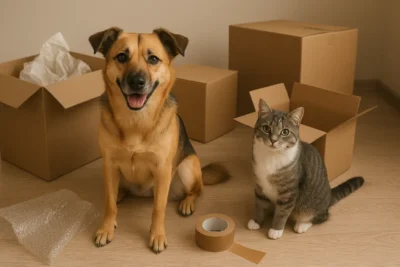The Essential Checklist for Moving with Pets: Expert Guidance from Express Lane Movers
Moving to a new home is a significant event for the entire family, including your furry, feathered, or scaled companions. Pets can experience stress during relocations, but with proper planning, you can make the process smoother and safer for them. At Express Lane Movers, we’ve assisted numerous pet owners in seamless moves, drawing on our experience to minimize anxiety and ensure well-being. This detailed checklist covers all stages of the move, from preparation to settling in, with practical tips for dogs, cats, birds, fish, and other pets. By following these steps, you’ll help your pets adapt quickly and thrive in their new environment.


Pre-Move Preparation: Setting the Stage for Success (4-8 Weeks Before)
Start early to give your pets time to adjust and ensure all logistics are in place. This phase focuses on health, documentation, and gradual changes to reduce shock.
- Schedule a Vet Visit: Take your pet for a thorough check-up. Update vaccinations, get flea/tick treatments, and obtain health certificates if moving across state lines or internationally. Discuss sedatives or calming aids if your pet is anxious during travel.
- Update Identification: Ensure microchips and ID tags have your current contact information. Add a temporary tag with your new address or a trusted contact’s details during the transition.
- Research Pet-Friendly Regulations: Check airline, hotel, or rental policies for pet restrictions. For long-distance moves, verify quarantine rules or breed-specific laws in your new area.
- Gather Supplies: Stock up on familiar food, medications, toys, and bedding. Purchase or clean carriers/crates that meet travel standards—ensure they’re spacious, ventilated, and escape-proof.
- Acclimate Your Pet: Gradually introduce them to the carrier or travel setup with positive reinforcement like treats. For car trips, take short practice drives to build tolerance.
- Plan for Special Needs: For exotic pets like reptiles or fish, research temperature-controlled transport. Birds may need covered cages to reduce stress from sights and sounds.
- Notify Service Providers: Inform your current vet and find a new one in your destination. Transfer records and prescriptions ahead of time.
Proper preparation helps prevent health issues and eases the emotional impact on your pets.

Packing Phase: Organizing Pet Essentials (1-2 Weeks Before)
Packing for pets involves prioritizing their comfort and safety items to avoid last-minute scrambles.
- Create a Pet Packing List: Include leashes, collars, litter boxes, food bowls, waste bags, and grooming tools. Pack extras in case of delays.
- Secure Hazardous Items: Keep cleaning supplies, medications, and small objects out of reach to prevent accidents during packing chaos.
- Label Pet Items Clearly: Use dedicated boxes for pet gear, marked “Pet Essentials—Open First” for quick access upon arrival.
- Prepare a Travel Kit: Assemble a bag with water, portable bowls, waste cleanup supplies, towels, and calming pheromones or toys. Include copies of health records and emergency vet contacts.
- Handle Aquarium or Terrarium Setup: For fish or reptiles, plan to transport them last. Use battery-powered aerators for fish and insulated boxes for temperature-sensitive animals.
- Avoid Overpacking: Don’t pack pet items too early—keep daily necessities accessible until moving day.
- Involve the Family: Assign family members to monitor pets during packing to keep them calm and away from movers.
Organized packing ensures your pets’ needs are met without interruption.

Moving Day: Prioritizing Safety and Comfort
The actual move can be the most stressful part for pets, so focus on containment and monitoring.
- Confine Pets Early: Place them in a quiet, secure room away from the action with food, water, and familiar items. This prevents escapes or injuries amid the bustle.
- Coordinate with Movers: Inform Express Lane Movers‘s team about your pets so they can work around them. If possible, have pets stay with a friend or at a boarding facility for the day.
- Transport Method: For short moves, use your vehicle with pets in carriers secured by seatbelts. For long hauls, consider pet-friendly transport services or climate-controlled options.
- Monitor Temperature and Stops: Never leave pets in a hot or cold vehicle. Plan breaks for walks, water, and bathroom needs—keep windows cracked for ventilation if stopped briefly.
- Administer Calming Aids: Use vet-approved remedies like anxiety wraps or natural supplements if recommended. Avoid feeding large meals before travel to prevent motion sickness.
- Emergency Preparedness: Have a pet first-aid kit, nearby vet locations en route, and identification ready in case of issues.
- Load Pets Last: Place them in the vehicle after everything else is loaded to minimize time in transit.
Careful handling on moving day keeps pets safe and reduces their stress levels.

Post-Move Adjustment: Helping Pets Settle In (First 1-2 Weeks After)
Once arrived, quick actions help pets acclimate to the new surroundings.
- Unpack Pet Areas First: Set up their bed, food station, and litter box in a quiet spot similar to the old home’s layout to provide familiarity.
- Supervise Exploration: Introduce rooms gradually under supervision to prevent hiding or destructive behavior from anxiety.
- Maintain Routines: Stick to regular feeding, walking, and play schedules to restore normalcy. Watch for signs of stress like hiding, loss of appetite, or accidents.
- Update Local Services: Register with a new vet, get local licenses if required, and microchip updates with the new address.
- Pet-Proof the Home: Check for hazards like loose wires, toxic plants, or escape routes. Install baby gates if needed for gradual access.
- Provide Extra Attention: Spend quality time with affection and play to reassure them. Consider pheromone diffusers for calming effects.
- Monitor Health: If symptoms persist, consult a vet. For multiple pets, ensure they readjust together without territorial issues.
Patience during this phase allows pets to bond with the new home comfortably.







